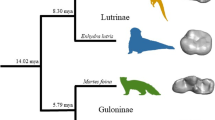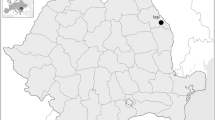Abstract
Anterior dental microwear is shown to be related to diet and to feeding habits in three groups of extant African primates includingPan troglodytes troglodytes, Gorilla gorilla gorilla andPapio hamadryas. Five distinct types of incisal microwear are found in these groups. These include: fine wear striae, polish, small pits, large pits and microflakes. It is demonstrated that each species exhibits a different set of microwear types. Chimpanzees exhibit extensive pitting, mesiodistally oriented fine wear striae and small areas of polish, features of microwear that are probably related to the husking of hard fruit skins and the occasional stripping of leaves. Gorillas show large areas of polish, small pits and labiolingually oriented wear striae, a combination of features that may be associated with the stripping of leaves and pith. Baboons show extensive edge damage involving clusters of large pits and microflakes; this set of microwear types may be related to the initial chewing of gravel-laden seeds, roots and rhizomes. Microwear found on the canine/premolar complex of all three groups corresponds to the puncture-crushing and to the slicing of food.
Similar content being viewed by others
References
Ahlgren, J., 1966. Mechanisms of mastication.Acta Odontol. Scand. Suppl., 44: 1–109.
Altmann, S. A. &J. Altmann, 1970.Baboon Ecology. S. Karger, New York.
Boucher, C. O., 1963.Current Clinical Dental Terminology. C. V. Mosby Co., St. Louis.
Butler, P. M. &J. R. E. Mills, 1959. A contribution to the odontology ofOreopithecus.Bull. Brit. Mus. Nat. Hist. (Geology), 4: 3–26.
Covert, H. H. &R. E. Kay, 1981. Dental microwear and diet: Implications for Determining the feeding behaviors of extinct primates, with a comment on the dietary pattern ofSivapithecus.Amer. J. Phys. Anthropol., 55: 331–336.
Crompton, A. W. &K. M. Hiiemae, 1970. Molar occlusion and mandibular movements during occlusion in the American opossum,Didelphis marsupialis. Zool. J. Linn. Soc., 49: 21–47.
Crook, J. H. &P. Aldrich-Blake, 1968. Ecological and behavioural contrasts between sympatric ground dwelling primates in Ethiopia.Folia Primatol., 8: 192–227.
DeVore, I. &S. L. Washburn, 1963. Baboon ecology and human evolution. In:African Ecology and Human Evolution,F. C. Howell &F. Bourlière (eds.), Viking Fund, Chicago, pp. 335–367.
Dunbar, R. I. M., 1976. Australopithecine diet based on a baboon analogy.J. Human Evol., 5: 161–167.
Goodall, J., 1963. Feeding behaviour of wild chimpanzees. In:Primates,J. Napier &N. A. Barnicot (eds.), Academic Press, New York, pp. 39–47.
————, 1965. Chimpanzees of the Gombe Stream Reserve. In:Primate Behavior,I. DeVore (ed.), Holt, Rinehart & Winston, New York, pp. 425–473.
————, 1968. The behaviour of free-living chimpanzees in the Gombe Stream Reserve.Anim. Behav. Monog., 1: 161–311.
Hiiemae, K. M. &A. W. Crompton, 1971. A cinefluorographic study of feeding in the American opossum,Didelphis marsupialis. In:Dental Morphology and Evolution,A. A. Dahlberg (ed.), Univ. of Chicago Press, Chicago, pp. 299–334.
Jones, C. &J. Sabater Pí, 1971.Comparative Ecology of Gorilla gorilla (Savage and Wyman)and Pan troglodytes (Blumenbach)in Rio Muni, West Africa. Bibliotheca Primatologica, No. 13, S. Karger, London.
Kay, R. F., 1973. Mastication, molar tooth structure and diet in primates. Ph.D. dissertation, Yale Univ., New Haven, Connecticut.
————, 1975. The functional adaptations of primate molar teeth.Amer. J. Phys. Anthropol., 43: 195–215.
————, 1977. The evolution of molar occlusion in the Cercopithecidae and early Catarrhines.Amer. J. Phys. Anthropol., 46: 327–352.
———— &K. M. Hiiemae, 1974a. Jaw movements and tooth use in recent and fossil primates.Amer. J. Phys. Anthropol., 40: 227–256.
———— &K. M. Hiiemae, 1974b. Mastication inGalago crassicaudatus, a cinefluorographic and occlusal study. In:Prosimian Biology,R. D. Martin,G. A. Doyle &A. C. Walker (eds.), Duckworth, London, pp. 501–530.
Kortland, A., 1962. Observing chimpanzees in the wild.Sci. Amer., 206: 128–138.
Kummer, H., 1957. Soziales verhalten einer mantelpavin.Gruppe Schweizzeitsch. Psychol., No. 33.
————, 1968.Social Organization of Hamadryas Baboons. Univ. of Chicago Press, Chicago.
————, 1971.Primate Societies: Group Techniques of Ecological Adaptation. Aldine, Chicago.
Merfield, F. G. &H. Miller, 1956.Gorilla Hunter. Farra, Straus & Cudahy, New York.
Mills, J. R. E., 1955. Ideal dental occlusion in the primates.Dent. Practner., 6: 47–61.
Nishida, T. &S. Uehara, 1980. Chimpanzees, tools and termites: Another example from Tanzania.Cur. Anthropol., 21: 671–672.
Reynolds, V., 1965.Budongo, an African Forest and Its Chimpanzees. Natural History Press, New York.
————, 1967.The Apes: The Gorilla, Chimpanzee, Orangutan and Gibbon. E. P. Dutton, New York.
———— &F. Reynolds, 1965. Chimpanzees of the Budongo Forest. In:Primate Behavior,I. DeVore (ed.), Holt, Rinehart & Winston, New York, pp. 368–424.
Ryan, A. S., 1979a. A preliminary scanning electron microscope examination of wear striation direction on primate teeth.J. Dent. Res., 58: 525–530.
————, 1979b. Wear striation direction on primate teeth: A scanning electron microscope examination.Amer. J. Phys. Anthropol., 50: 155–168.
————, 1979c. Tooth sharpening in primates.Cur. Anthropol., 20: 121–122.
————, 1980. Anterior dental microwear in hominoid evolution: Comparisons with human and nonhuman primates. Ph.D. dissertation, Univ. of Michigan, Ann Arbor, Michigan.
Sabater Pi, J., 1966a. Rapport préliminaire sur l'alimentation dans la nature gorilles du Rio Muni (Ouest Africain).Mammalia, 30: 235–240.
————, 1966b. Gorilla attacks against humans in Rio Muni, West Africa.J. Mammal., 47: 123–124.
Schaller, G. B., 1976.The Mountain Gorilla: Ecology and Behavior. The Univ. of Chicago Press, Chicago.
St. Hoyme, L. E. &R. T. Koritzer, 1971. Significance of canine wear in pongid evolution.Amer. J. Phys. Anthropol., 35: 145–148.
Suzuki, A., 1969. An ecological study of chimpanzees in a savanna woodland.Primates, 10: 103–148.
Swindler, D. R., 1976.Dentition of Living Primates. Academic Press, London.
Teleki, G., 1974. Chimpanzee subsistence technology: Materials and skills.J. Human Evol., 3: 575–594.
————, 1975. Primate subsistence patterns: Collector-predators and gatherer-hunters.J. Human Evol., 4: 125–184.
Walker, A., 1979. SEM analysis of microwear and its correlation with dietary patterns.Amer. J. Phys. Anthropol., 50: 489. (Abstract).
Walker, P. L., 1976. Wear striations on the incisors of Cercopithecid monkeys as an index of diet and habitat preference.Amer. J. Phys. Anthropol., 45: 299–307.
Washburn, S. L. &R. L. Ciochon, 1974. Canine teeth: Notes on controversies in the study of human evolution.Amer. Anthropol., 76: 765–784.
Weier, T. E., C. R. Stocking &M. G. Barbour, 1970.Botany: An Introduction to Plant Biology. John Wiley & Sons, Inc., New York.
Wrangham, R. W., 1975. The behavioural ecology of chimpanzees in Gombe National Park, Tanzania. Ph.D. dissertation, Univ. of Cambridge, Cambridge.
Zingeser, M. R., 1969. Cercopithecoid canine tooth honing mechanisms.Amer. J. Phys. Anthropol., 31: 205–214.
Zuckerman, S., 1932.Social Life of Monkeys and Apes. Harcourt & Brace, New York.
Author information
Authors and Affiliations
About this article
Cite this article
Ryan, A.S. Anterior dental microwear and its relationship to diet and feeding behavior in three african primates (Pan troglodytes troglodytes, Gorilla gorilla gorilla andPapio hamadryas). Primates 22, 533–550 (1981). https://doi.org/10.1007/BF02381245
Received:
Accepted:
Issue Date:
DOI: https://doi.org/10.1007/BF02381245




